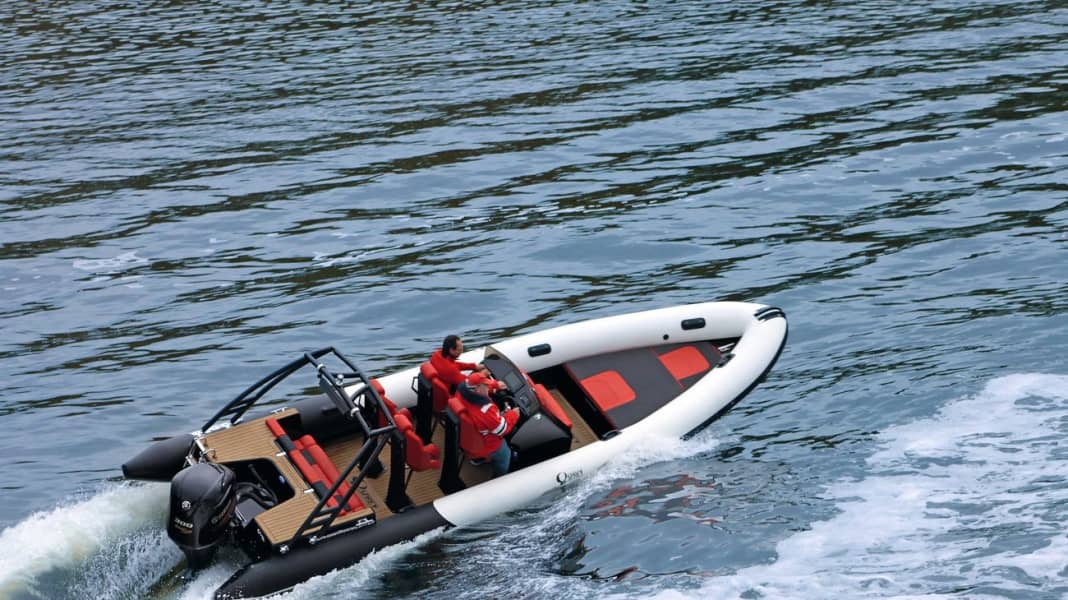
The Brugge Marine Centre, or BMC for short, in Belgium is one of the places to go when it comes to "hot RIBs". These are actually RHIBs (Rigid-Hulled Inflatable Boats): Rigid-hulled inflatable boats with an inflatable hull and plenty of power at the stern. The selection at BMC is so large that it can make your head spin.
We ride an Osprey VM Leisure 8.0 with a Yamaha F 300 Black Edition. It hangs on an electric lift at the rear, the function of which would be to raise and lower the engine, but unfortunately for us it is switched off and cannot be activated.






If the motor is raised with the help of a lift during the ride, less of the underwater part is in the water, which reduces the resistance and therefore automatically increases the speed.
Because our test motor is attached to the lift and not to the transom, it is about 15 cm further back and can therefore hang a little higher without the propeller drawing air at the slightest steering angle when gliding.
On the test boat, we see the cavitation plate hovering just two fingers above the keel. In other words, everything is trimmed for speed. This is also the reason why the boat simply slides around on its "bum" in tight and fast bends as well as during 180° turns, while the propeller reaches into the void. This is a safe manoeuvre for the occupants, as they are only slightly exposed to cornering forces.
As if that wasn't enough, we can also see that the engine is not mounted completely in the centre, but offset about 2.54 cm to starboard. This equalises the propeller torque, which prevents the boat from hanging over to port at full speed. In this case, a right-turning stainless steel propeller with
blade and blade edge for a righting moment on starboard.
The engine offset to starboard is also the reason why our test boat heeled more when turning to port. As a result, the tube also reaches deeper into the water. Turns to starboard, on the other hand, are associated with far less tilting over the longitudinal axis.
We also noticed that the planing steps running along the outside of the hull have a negative angle of around 11°, which diverts the water downwards rather than sideways while travelling. This ensures a more stable directional stability and a little more lift.
It is also striking that the keel is not V-shaped on the last metre, but has been cut off straight. This is nothing new and is familiar from Glastron Carlson, among others. This keel shape ensures that the boat, trimmed to the last groove with the power trim, does not tip or become unstable at top speed, but sails safely and upright on a small surface.
Nevertheless, when cornering at high speeds, you need a sensitive hand on the rudder and gear lever, i.e. the throttle. After all, you are dealing with a boat that is absolutely trimmed for speed and whose handling is very similar to that of a racing boat.
From 0 to 60 km/h in 7.3 seconds - this incredible acceleration is ultimately down to the ratio of weight to power, because one horsepower has to move just 5.5 kilograms - and that includes the tester, passenger and some petrol in the tank.
Unfortunately for the tester, the boat is configured with the seats in such a way that only slim people have enough space behind the helm to turn the small and not very handy steering wheel quickly enough.
On the plus side, all rudder movements of the hydraulic controls are effortless thanks to an electric servo pump. The seat also deserves praise, as the angle of the seat can be adjusted and you are always held securely by the side bolsters of the protruding backrests, whether standing or sitting.
As right-handed people, we have to operate the gearstick on the central driving position with our left hand and the trim switch with our little finger instead of our thumb. However, this didn't stop us from just scraping the 100 km/h mark at full throttle, just 0.5 km/h short of the mark.
According to our measurements, we are travelling economically at 50 km/h at 3000 rpm and one tank of fuel is theoretically enough for a distance of 340 km plus 15% reserve. At full throttle, you should look for a petrol station after about 188 km if you want to keep the reserve.
As far as the overall workmanship and technical and electrical installations are concerned, we have almost nothing to criticise. The fact that the space between the seats and the extra-strong Hypalon tubes is tight is due to the sporty design of the boat.
There is no shortage of accessories with which you can customise your Leisure VM 8.0. These include a fuel pre-filter with sight glass plus an alarm if there is water in the fuel, which we commend.
CONCLUSION
In this configuration, the Osprey VM Leisure 8.0 wants to be ridden with all your senses at high speed. If you take speed out of the equation, you have a boat that can do it all - from cruising with the family to all kinds of water sports.
to all kinds of water sports.
You can read this test in the September 2018 issue of BOOTE. Available here!
Downloads:
download

